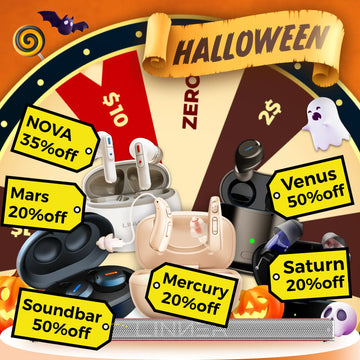When it comes to digital hearing aids, one of the most important technologies that affect their performance is the WDRC, or wide-dynamic-range-compression. This technology is designed to improve the amplification of sounds by processing the audio signal based on loudness. However, not all hearing aids with WDRC technology are created equal. In this article, we will delve deeper into how WDRC technology works and how it affects the performance of hearing aids, particularly on the LINNER Nova.
Hearing aids without Wide-Dynamic-Range-Control (WDRC) technology
Before the advent of digital hearing aids, traditional analog hearing aids relied on linear amplification, which simply amplified every sound equally, regardless of its loudness or frequency. This meant that loud sounds could become unbearable, while quiet sounds could go unnoticed. The introduction of WDRC technology solved this issue by allowing hearing aids to process the audio signal based on loudness. If the sound is too loud, the hearing aid decreases the gain, and if the sound is too small, the hearing aid increases the gain. This ensures that both loud and soft sounds are comfortable and audible for the user.
What is WDRC?
WDRC technology has been introduced to address this issue by processing audio signals based on loudness. With WDRC, hearing aids can automatically adjust the gain depending on the loudness of the sound. If the sound is too loud, the gain is decreased, while if it is too soft, the gain is increased. For instance, if there are two audio inputs with frequencies of 1000Hz at 70dB and 3000Hz at 30dB, the hearing aid would apply less gain to the 1000Hz input, resulting in an output of 90dB. Conversely, it would apply more gain to the 3000Hz input, also resulting in an output of 90dB, making both sounds audible and comfortable for the user.
Channel Impact on WDRC Technology
Channels are a critical component of WDRC technology, as each sound has its own frequency range that requires individual processing. For instance, low-frequency sounds such as the bass of a drum or the sound of an engine require less amplification, while the mid-range covers human voices, and the treble produces high-pitched and sharp sounds that contribute to the overall detail of the audio. Channels divide the frequency range into different segments, enabling individual WDRC application for each segment. LINNER Nova, for example, supports up to 16 channels, allowing for precise sound reproduction. Suppose there are four audio tracks, including 1000Hz 30dB, 1000Hz 70dB, 3000Hz 30dB, and 3000Hz 70dB. In that case, the 1000Hz 30 dB audio would be processed with a 10dB gain and become 1000Hz 40dB, the 1000Hz 70dB audio would be processed with a 20dB gain and become 1000Hz 90dB, the 3000Hz 30dB audio would be processed with a 30dB gain and become 1000Hz 60dB, and the 3000Hz 70dB audio would be processed with a -10dB gain and become 1000Hz 60dB. This demonstrates that the least audible frequency in this scenario is 1000Hz 30dB, while the most audible frequency is 3000Hz 30dB. In general, the more channels that a hearing aid supports, the more accurately it can process sound.
WDRC Technology on LINNER NOVA Hearing Aids
 (Figure for reference only)
(Figure for reference only)
The LINNER Nova supports up to 16 channels, which is typically found on hearing aids priced around $2,000. With a frequency range from 0Hz to 8000Hz and an interval of 500Hz, the LINNER Nova can process sound in great detail.
Additionally, the LINNER Nova allows for up to four different input sound levels, with different WDRC parameters applied to each level. All parameters are customizable so our engineer could tune the sound in detail until reaching the best audio performance.
Four WDRC modes
As we can see in the LINNER HA App, LINNER Nova can switch between four modes: Dialogue, Restaurant, Commute, and Outdoor. Each mode represents a unique WDRC parameter that is specifically optimized for typical environmental situations. For example, Dialogue mode emphasizes the human sound frequency range, while Restaurant mode reduces the gain of low frequency to reduce noise.
As a result, LINNER Nova can process sound with 64 methods based on its frequency and loudness. This enables comfortable amplification of loud sounds and improved audibility of soft sounds.





